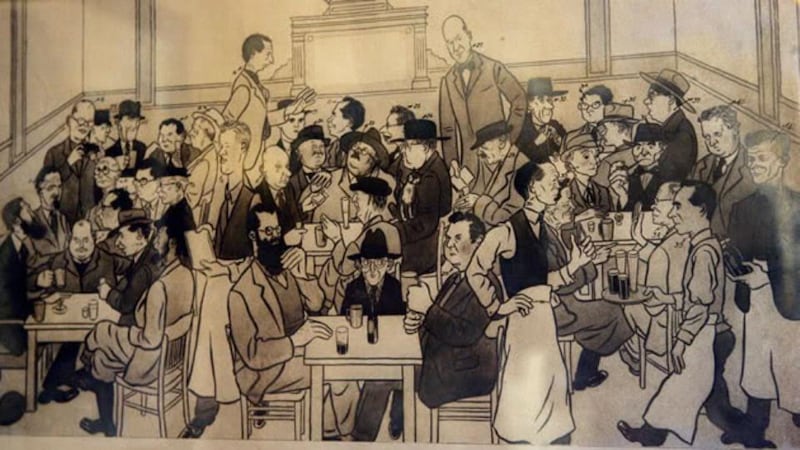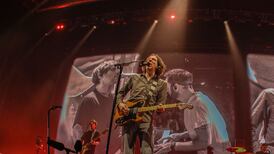When one thinks of literary coteries or artistic circles, one immediately thinks of Parisian cafe society in the 1930s, or the Bloomsbury set in the city of London, or closer to home and the literary pubs such as McDaids or the Palace Bar, frequented by Brendan Behan and Patrick Kavanagh and their cohort of writing men. What is less known is the literary landscape of Dublin’s female avant-garde writers in post-revolutionary Ireland, what the poet and saloniere Blanaid Salkeld called the “arty set”, that congregated in well-known eateries in the 1930s, 1940s and 1950s. They met at the Country Store in St. Stephen’s Green, Robert’s Cafe on Grafton Street, Jammet’s French restaurant on Nassau Street, the Arts Club in Lincoln Building, and the exclusive hotels, The Gresham, Jury’s and the Hibernian, where they held glitzy annual balls and dinners.
For centuries, writers and poets have congregated in urban spaces, supporting a literary culture that is brought to life through their poetry and prose. So too, Irish women writers, actors, painters, and journalists of the mid-twentieth-century socialised in a heady atmosphere of arty conversation and political raillery, and actively campaigned on issues which affected their rights as citizens. They hosted annual banquets to network with influential people in theatre and the media, invited writers (male and female) to their “at homes” to discuss art and literature, and publicly promoted the work of their members through a literary award system; while invoking the creed of “l’art pour l’art’’, put forward by modernist intellectuals.
Some of Ireland’s best known novelists, poets, children’s writers and political activists circulated in this artistic milieu, who formed a formal club under the title of the Women Writers’ Club. Set up by Blanaid Salkeld, and presided over by Dorothy Macardle in 1933, the club lasted more than 25 years, celebrating its Silver Jubilee in the Royal Hibernian Hotel in 1958. During its tenure, it fostered a vibrant and dynamic coterie tradition, and kept women writers at the forefront of literary life. Many of Ireland’s leading women writers supported the club: Elizabeth Bowen, Helen Waddell, Maura Laverty, Winifred. Letts, Sybil le Brocquy, Patricia Lynch, Temple Lane, Rosamond Jacob, Hanna Sheehy Skeffington, Nora Connolly O’Brien, Christina Longford and Teresa Deevy, to name a few. They met monthly with the aim, as Ethel Davidson, president of the club in 1937, declared, to sharpen “the wits, and improving the standard of criticism, as well as encouraging the writers “.

The shaping of a literary culture and the notion of the book as a commodity, what artist Louis le Brocquy called “the thing itself”, was opportunistically seized by the club, as they used their commercial astuteness to navigate their way into the book trade. The artist’s mother, the writer Sybil le Brocquy, was one of the women writers who initiated a literary prize, the Book of the Year award. This well-publicised award, recorded in the columns of the national presses of the period, lent prestige and symbolic capital to the recipients, and to the club. Indeed, when Patricia Lynch won first prize for her children’s novel Fiddler’s Quest, in 1942, her London-based publishers, Dent & Sons were delighted. They sent her a letter congratulating her, and circulated the news to the Bookseller, “the best trade paper here, and in which the notice will be most likely bear fruit”.
The Book of the Year award represented the ethos and philosophy of the Women Writers’ Club. What is striking is their advanced, up-to-date ideas that were very twentieth-century. Despite their differences in literary style, output and even merit, these women writers produced texts with common themes and ideas, and their poetry, prose and plays offered feminist messages of empowerment through education, independent thought, and resistance to cultural norms. Much of their work addresses the truth about women’s lives and experiences, dealing with taboo subjects such as unhappiness in marriage, adultery and repression of women by religious institutions.
Internationally renowned recipients of the Book of the Year prize included: Elizabeth Bowen, for her novel Death of the Heart in 1939; Helen Waddell for her translation The Desert Fathers, in 1937; Kate O’Brien for her two novels That Lady and The Flower of May in 1946 and 1953 respectively; and British writer Ethel Mannin for her bestselling novel Late Have I Loved Thee, in 1948.
Historical books feature strongly in the list of prizes: Edna Fitzhenry won the prize in 1937 for her history book Henry Joy McCracken; activist and writer Rosamond Jacob won in 1958 for her historical fiction The Rebel’s Wife; and Nora Connolly-O’Brien won in 1936 for her autobiographical book, Portrait of a Rebel Father. These texts recount the histories of well-known republican heroes, but they also question the polarity of these male-oriented narratives. As a counter-strategy, their writings valorise heroic women and the wider family networks involved in the struggle for freedom from colonisation.
But by far the most important (and most read) of the republican histories was written by Dorothy Macardle. Macardle, who was an established playwright with the Abbey and the Gate theatres and a well-known novelist of the period, won the award in 1938 for her critically acclaimed The Irish Republic. It was described by Eamon de Valera in the preface as “an exhaustive chronicle of fact and provides the bases for an independent study of the period and a considered judgement upon it”. These histories included – indeed insisted on emphasising – the leading role of women in the struggle for Irish independence, a story which is only coming to light in recent historiographies.
Plays by Teresa Deevy, children’s fiction by Patricia Lynch and travel narratives by Ena Dargan form part of the body of works celebrated by this club.
Reading through the columns and editorials of the archives of the national press and in particular The Irish Times, one is struck by the influence this group of women exerted on current issues. They fought vigorously on issues such as the status of women in the 1930s, participated in the League of Nations efforts to promote women in the professions, and joined with other feminist grassroots to demand changes to the draft constitution of 1937. Their relentless lobbying, using their connections and networks in government circles, media and official Ireland, ensured that their rights as citizens was not diminished.
Mary Manning, writer and editor of the periodical of the Gate Theatre, The Motley, described the changing nature of Ireland in the mid-twentieth-century: “Ireland is in transition: the nation is finding its soul. New forces are at work; new ideas are crowding in upon us”.
Individually, they produced an argosy of books that would fill many anthologies and critical journals for decades to come; collectively, as a club, they relentlessly promoted women in the professions and celebrated a corpus of women’s writing that relayed the truth about women’s lives, experiences and sexuality. This radical group of women writers fostered a literary canon that was distinctive and modern, and decidedly female. Why they were forgotten is speculative. However, their story is unique and worth telling and remembering. Indeed, it serves as a model for literary women, or activist groups today.
Dr Deirdre Brady lectures in the School of Culture & Communication, University of Limerick. Deirdre.brady@ul.ie















